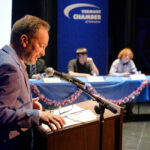Navigating Federal Tax Reform: Impacts for Vermont Businesses
In a sweeping move with far-reaching implications, the Big Beautiful Bill Act (OBBBA) was signed into law on July 4. The federal budget bill introduces significant reforms to business taxation, reshaping how employers plan investments, manage cash flow, and support their workforce.
Recognizing both the complexity and opportunity in these changes, the Vermont Chamber has partnered with Gallagher, Flynn & Company (GFC) to launch the Tax Insights & Business Intelligence series. The July 29 webinar, Big Bill, Big Impact: What Vermont Businesses Need to Know About Federal Tax Changes, served as the kickoff session, giving Vermont employers a practical breakdown of the most consequential provisions of the new law.
Key provisions include:
100% Bonus Depreciation: Restores 100% bonus depreciation for qualifying assets placed in service 2025–2029, letting businesses fully write off investments immediately. This will boost cash flow and encourage companies to move forward with major capital investments sooner.
Section 179 Expensing Increase: Raises the Section 179 expensing limit from $1M to $2.5M with a higher phase-out threshold, allowing more purchases to be deducted right away. This benefits businesses by helping them recover costs faster and improve their financial flexibility.
Instant R&D Write-Off: Ends the requirement to amortize domestic R&D costs over five years and allows certain small businesses to apply this retroactively to 2022–2024. This change will free up cash sooner for innovation, product development, and expansion plans.
Easier Interest Deduction: Changes the interest deduction limit calculation from EBIT back to EBITDA, expanding allowable deductions. This will ease the tax burden for capital-intensive businesses that rely on financing to grow.
Permanent 20% Pass-Through Deduction: Makes the 20% pass-through deduction permanent beyond 2025. This will provide long-term tax relief for S-corps, partnerships, and sole proprietors, improving competitiveness with larger corporations.
Bigger Employer Child Care Credit: Increases the employer-provided childcare credit rate, raises the cap, and expands eligible arrangements. This will create financial incentives for companies to offer childcare support, helping them attract and retain skilled workers.
Rollback of 1099-K Reporting: Rolls back the 1099-K reporting threshold from $600 to $20,000/200 transactions. This reduces compliance headaches and paperwork for small sellers, gig workers, and businesses using online payment processors.
These reforms are intended to spark investment and innovation, but the complexity of implementation means Vermont businesses will need timely guidance to capture the benefits and avoid pitfalls.
The Tax Insights & Business Intelligence series will build on this first webinar with brief video explainers, downloadable issue briefs, and additional programming aimed at supporting informed decision making. The Vermont Chamber will continue to advocate for policies that protect competitiveness while ensuring Vermont employers have the resources they need to thrive in a shifting federal and state landscape.










